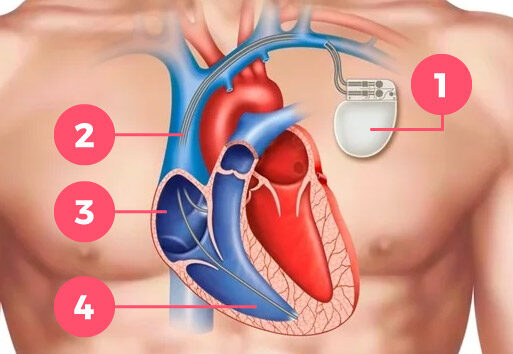A pacemaker is used if a patient’s heart rate is too slow. There can be a number of different reasons for this. It could be because there are not enough impulses being produced in the sinus node (see the article “A little about the heart”), known as Sick Sinus Syndrome, or because the impulses from the atria are not able to reach the heart chambers, known as an AV block. A pacemaker can be used to help ensure that the right signals are reaching the heart. It may also be a nescessary underlay for medical treatment if this inappropriately lowers the heart rhythm.
A standard pacemaker consists of the housing and two leads, one to the right atrium, and one to the right ventricle:

- Pacemaker
- Pacemaker-leads
- Right atrium
- Right ventricle
A pacemaker is able to feel the heart’s rhythm and use an electrical current to help regulate a patient’s heartbeat. If the heart is functioning correctly, the pacemaker simply monitors its condition. If the pacemaker detects that the heartbeat is beginning to slow, it will send an impulse to the heart in order to ensure that the patient’s heart rate increases. A pacemaker also contains an accelerator which is able to increase a patient’s heart rate when you are in motion, and bring it down when you are at rest.
The pacemaker can be adjusted without surgery via a small computer and an associated magnet. Often, pacemakers are controlled remotely from the implantation center via a transmitter to the web.
Pacemaker implantation takes about an hour. This operation is fairly straightforward and can be performed under local anesthesia. It is normally performed as an outpatient procedure, leaving the hospital on the same day as implantation.